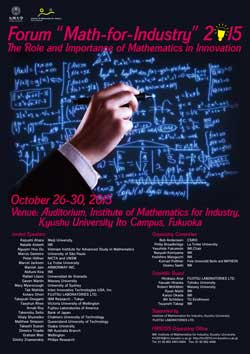CONFERENCE POSTER
COMMITTEE
- Organizing Committee
- Bob Anderssen (CSIRO, Australia)
Philip Broadbridge (La Trobe University)
Yasuhide Fukumoto (IMI), Chair
Naoyuki Kamiyama (IMI)
Yoshihiro Mizoguchi (IMI)
Konrad Polthier (Berlin Freie University)
Osamu Saeki (IMI)
- Scientific Board
Hirokazu Anai (FUJITSU LABS. LTD.)
Yasuaki Hiraoka (Tohoku University)
Robert McKibbin (Massey University)
Ryuei Nishii (IMI)
Kanzo Okada (IMI)
Wil Schilders (TU Eindhoven)
Tsuyoshi Takagi (IMI)
- Supported by

- Co-Sponsored by


NEW TOPICS
-
- 2015.11.04
Poster Session Award Winners !!- 2015.10.14
- Access & Travel Information Up! Please go to ACCESS.
- 2015.09.16
- Details of Excursion & Banquet Up! Please go to REGISTRATION.
- 2015.09.08
- Program Up! Please go to PROGRAM.
- 2015.07.17
- Poster Up!
- 2015.06.15
- Website Open !
FMfI2015 SYNOPSIS
The Role and Importance of Mathematics in Innovation
Synopsis
Innovation: a new idea, device, process or method;
the act of identifying new ideas, devices, processes or methods.
Innovation is in fact the cornerstone of creativity in all human
endeavours. It involves “seeing” things from an entirely new, sometimes
quite elementary, perspective. This a direct consequence of the fact
that complex structure are a compendium of simpler components.
Innovation in mathematics is the bread-and-butter of mathematical
creativity. Historical examples of mathematical innovation, which have
had profound and lasting impacts on the subsequent development of
mathematics, include the logarithm, complex numbers, non-Euclidean
geometry and calculus. Equally important is the innovation in the
performance of mathematics which can be disarmingly simple but have
profound consequences. Examples include adding zero, multiplication by
one, seeing a new interpretation which simplifies matters, etc.
In supporting innovation in science, technology and daily life,
mathematics plays two different key roles.
(i) Needs-Based. Once a need or an opportunity for innovation has been
identified, the subsequent experimentation and/or lateral thinking
utilizes mathematics to assist with sorting through the possibilities
and putting matters on a more rigorous foundation. An example is the
development of Wifi.
(ii) Idea-Based. After an idea for an innovation has materialized,
mathematical models of the possibility implementations play a key role.
An example is the design of the next model of an automobile that
exploits recent developments in materials and technology.
Being able to innovate comes from experiencing and understanding how
innovation occurs in mathematics, science and technology. A practical
example of innovative-in-action is the problem-solving that occurs at
MinISG and MforISG. In fact, industry study groups, by working on
problems coming from industry, are directly involved with stimulating
and performing innovation.



